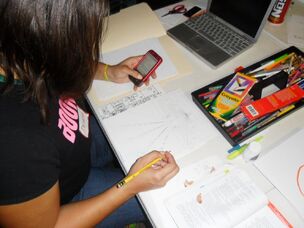
Part-time graphic novelist...
I chose the National Museum of the American Indian as the subject of my month-long investigation into Museum Informatics, because I just spent three years teaching Native American teenagers in New Mexico. Ellis Island was my other potential research location, as I want to see my great-grandparents' names on the wall, but free admission and being open every day didn't hurt NMAI on the pro/con list. The real answer, however, is that the Smithsonian's foray into creating a culturally-focused institution is something an African & African-American Studies major from Dartmouth can't resist. They are going to build an African-American museum within the next five years, so a window into NMAI is worth looking in.
The more time that I spent investigating this particular museum, the more it helped me figure out the direction I would like to take with my library career as well. Museum education is a natural temptation, and I am also interested in making websites and designing videogames - in being the techy sci-fi librarian of the future... But I am still intimidated by IT. However, I have been using a computer since the TI-99/4a, and I think I am finally realizing that I can build a bridge from humanities to computer science through librarianship and information science; the more I learn about using ICT to apply the Five Laws of Library Science, the better a humanties scholar I will be in the 21st century.
I am impressed with the amount of technology that the Smithsonian already uses. They are obviously leaders in most of the communities of practice they belong to. I was disappointed with the amount of human remains that they have yet to return since NMAIA. I read the criticism for and against the museum and tried to report objectively based on the questions that were asked in class, but I do worry that my words online will have a meaning that I didn't intend, or be interpreted as a blanket endorsement for the Smithsonian. Also, I can't help but wonder how the national museum will tell the (his)tory of African-Americans.
During the two weeks that we were in class, I completed several pages of analysis of the museum's use of information technology, and at times I was overwhelmed because the Smithsonian offers a lot. Some of the pages, in the end, remain bulleted points and others were fleshed out completely with slideshows, links, and images. When I got the message that several of my pages were "orphans", I tried to respond as quickly as I could. Like worrying about the interpretation of the NMAI information I present here, I also worry about the presentation of my work online. Even now that the course has come to an end, I know that I will find myself editing these pages over and over again, because they are associated with me and now they are out there in public. As I inferred earlier, in order to be 21st century academic I will have to become okay with having an online presence. I plan to be a digital humanities scholar.